Science and religion. Order and chaos. Innovation and tradition. These dualities are often cast as opposing forces in tension, destined to repel one another.
But on the playa, and at Regional Burns around the world, these supposed opposites don’t just meet; they fuse. The boundary between artist and technologist dissolves, revealing itself as a false distinction all along.
In these settings, art demands engineering. Engineering bows to beauty. And what emerges shapes the skylines of cities, the tools of future artists, and the cultural imagination around what technology — even AI — can become.
From Code to Catharsis: “The Moonlight Library” and One Technologist’s Turn Toward Art
Over a decade ago, James Gwertzman arrived at Burning Man as a technologist, having spent nearly three decades building virtual video game worlds. Now, as the founder of immersive art group The Moonlight Collective, the group behind “The Prairie of Possibilities,” James calls himself an artist.
For James and the Moonlight Collective, this year’s ambitious piece debuting in Black Rock City, “The Moonlight Library,” stands as a testament to the transformative possibilities of art, technology, and community when given a vast, open space and a willing audience. Rising from the playa like the windswept ruin of some forgotten civilization, “The Moonlight Library” will create a space where story and technology converge — a physical library of real books, suffused with subtle magic.
Among the thousands of volumes that sit on the library shelves, a select few will be “imbued.” Touch the spine of one, and it will speak — softly releasing stories gathered from participants at the Moonlight Collective’s 2022 and 2023 Black Rock City installation, “The Prairie of Possibilities.” Underneath the “vellum” and dust will be capacitive touch sensors, microcontrollers, and a hidden network of computers relaying messages through a local system, triggering speakers, lights, and sounds. It is a quiet technological feat designed to feel ancient, inevitable, and natural.
“Technology makes it possible to create a level of interactivity that facilitates transformation even more effectively,” James explains. “In our case, being able to play back stories allows visitors to immerse themselves more deeply in the idea that we’re all just stories in a library.”
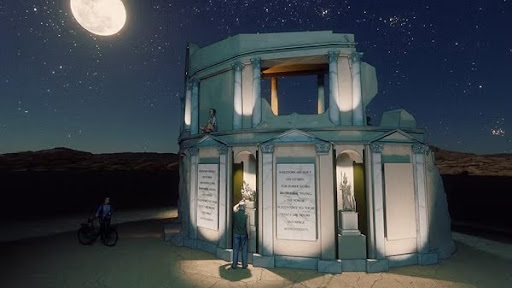
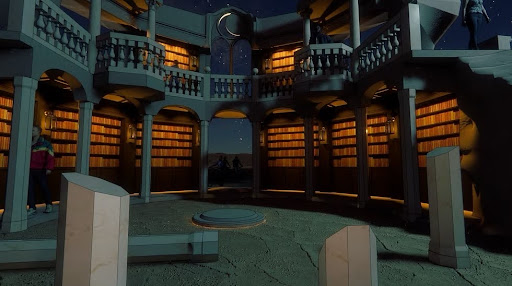
Though James built his career on screens and code, he started by building theater sets in high school. Now, he finds himself drawn back to the tactile, to the theatrical, and the physically immersive. “I always wanted to build theme park rides as a kid,” he laughs. “This is that, in a way.” After years in games, Burning Man reawakened a dormant creative longing. “I identified as a game executive, a techie,” he says. “But this experience of building art on the playa has been so gratifying, I’m committing more and more of my life to it. I want this to be my work going forward.”
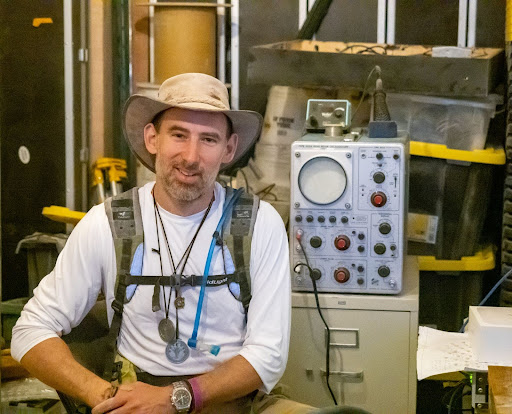
“The Moonlight Library” — like its creators — could not exist outside the unique alchemy of Burning Man. “People come to the desert ready to believe,” James says. “They’re primed to accept and welcome wonder. The art feeds on that enthusiasm. It becomes more powerful.”
And so, a technologist becomes an artist. A ruin rises in the dust. And a library whispers: we are all stories, and our endings are still unwritten.
The Sculpture That Listens: “Out The Other” and AI’s Empathetic Potential
Kate Greenberg didn’t set out to champion AI in her art. As an artist and architect known for bringing complex sculptural environments to Black Rock City, she approached machine learning with skepticism. But for her 2025 installation, Kate is embracing cutting-edge technology to explore something profoundly human: heartbreak, healing, and the stories we tell ourselves to survive.
At first glance, “Out the Other” appears to be a serenely seated female figure, just slightly larger than life. But tell it something vulnerable, something you struggle with, and the figure responds. Soft lights indicate awareness; speech-to-text AI processes your words. An AI “mind” reframes them into language of care and compassion. A 3D-printed heart and brain glow in reaction to emotional tone, beating faster or slower, lighting up in quiet acknowledgment. It’s interactive art taken to a new level: “Out The Other” is designed to listen, reflect, and model emotional resilience.

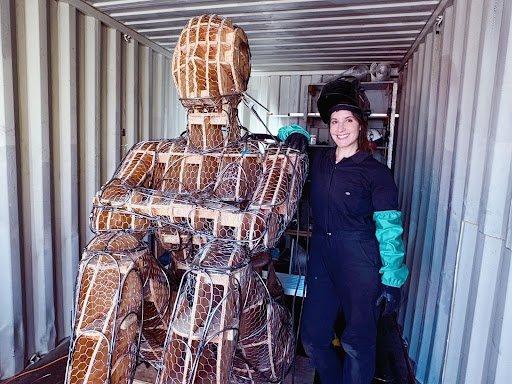
Visitors can approach with anything — sorrow, loneliness, frustration, or joy. And rather than dispensing advice, the sculpture will transform whatever is shared.
“It’s basically an AI empath,” explains Deva Temple, the project’s lead prompt engineer. “It internalizes what you say and mirrors the process of moving through difficult emotions to arrive somewhere lighter.”
Should someone express deeper distress, the AI has been trained to break character and offer resources, a nod to safety and care in a setting where emotions can run high.
For Deva, this project provides a powerful opportunity to rewrite the cultural narrative around AI. “Everything we put online trains future AI systems,” she notes. “All the narratives we build about what AI is and how it behaves, that feeds it. Shifting those narratives is important. Projects like this show that AI can be empathetic, reflective. We don’t have to accept the dystopian storylines we’ve been given. We can build something else.”
Burning Man, with its culture of radical experimentation, is the perfect proving ground. “It’s a place where people are more vulnerable, more open to wonder and connection,” Kate says. “That makes it an ideal setting to explore technology that’s asking us to look inward.”

To learn about more pieces coming to BRC in 2025 that incorporate AI in fascinating new ways, listen to this episode of the Burning Man LIVE podcast.
From Desert Laboratory to Urban Canvas: Ben Davis and Illuminate
While numerous projects elicit catharsis on playa, Ben Davis’ work in San Francisco with Illuminate is a vivid demonstration of Burning Man’s transmutation of art and technology into civic possibility. His journey from the dust of Black Rock City to the luminous skyline of San Francisco captures how temporary desert experiments can evolve into permanent urban legacies.
Ben first attended Burning Man in 2003, an experience that left him both energized and contemplative. “I see all this energy, people giving up six months of their life working for this one event, way out in the desert, lasting for a week and then Leaving No Trace, which is both beautiful and kind of frustrating to me,” he recalls. This tension between the ephemeral brilliance of Black Rock City and the enduring needs of cities planted a seed.
Two weeks after returning from the playa in 2010, Ben found himself sitting at San Francisco’s Ferry Terminal watching the sunlight shine through the Bay Bridge cables. In that moment, he experienced what he describes as a vision: the bridge revealing itself as a canvas for light. And thus was born The Bay Lights, a monumental artwork of 25,000 individually programmed LED nodes illuminating the Bay Bridge in shifting patterns. Working with the light artist and fellow Burning Man veteran (and Burning Man Project board member) Leo Villareal, Ben helped shepherd the project from an audaciously improbable idea to shimmering reality.
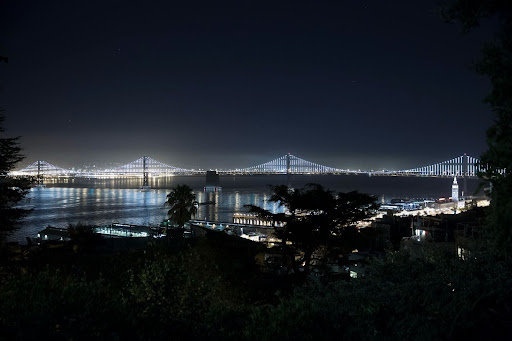
For more on how Burning Man shaped the creative journey of artist Leo Villareal — from the playa to the Bay Lights and beyond — listen to his conversation on Burning Man LIVE Podcast:
For Ben Davis, The Bay Lights was a turning point. “Part of what I was thinking about, somewhat consciously and unconsciously, is how can you take all this beautiful Burning Man energy and just bring it where people live and let it last longer?” he says. Answering this question became his calling. He left his boutique communications firm behind and founded Illuminate, a nonprofit dedicated to transforming San Francisco through large-scale, light-based public art.
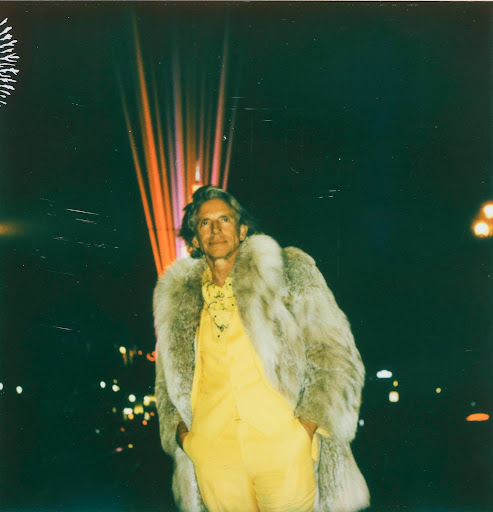
Illuminate’s works span from the laser beams stretching across San Francisco’s Market Street, to Grace Cathedral’s ethereal Gracelight installation, to championing, shepherding, and fundraising for the installation of the artwork “Naga & the Captainess” newly arrived in Golden Gate Park’s Rainbow Falls Pond, also lending Illuminate’s 501(c)(3) status to the effort to receive donations. While not exclusively working with Burning Man artists, Davis acknowledges the shared DNA: “We’re always in that ecosystem. Essentially, we’re covered in playa dust.”

Illuminate’s projects channel the ethos of the playa into the urban realm: no corporate sponsorship, no ticketed entry. Just radical generosity and a belief in beauty as a public good.
Through these efforts, Ben articulates a philosophy of urban stewardship that mirrors Black Rock City’s Principle of Leaving No Trace adapted for an urban civic context: “In some ways, you want to leave the place you are in cities better. You’re not returning to nature. You’re trying to figure out how to create a better place.”
Illuminate’s work proves that the alchemy of art and technology forged in the desert can extend far beyond the fence line of Black Rock City. Through light, through beauty, through generosity, Illuminate models the possibility of year-round cities remade through wonder.
For more reflections on how Burning Man shapes innovation beyond the desert, listen to Wired Magazine founder Kevin Kelly share how he envisions an optimistic future in this Burning Man LIVE episode:
The Eternal Return
And so the cycle continues. Each year, new creators arrive in Black Rock City: artists drawn to circuits and code, technologists pulled toward wonder and story. They come to a place where survival demands ingenuity and beauty demands invention. They build things that shouldn’t work… and then make them work anyway.
What they often discover, knowingly or not, is something the ancient Greeks understood long before silicon chips or LED nodes or neural networks arrived on the scene: the root of the word technology, technē, was never about choosing between art and technology. Technē meant artfulness itself, the human drive to make, to transform, to shape raw matter into meaning. To build not just for function, but for beauty. To craft something that lasts, or something that vanishes, but leaves an imprint all the same.
Liberated from the white box of the art gallery, free to expand into the limitless-feeling beige box of the desert, the same phenomena happens over and over: what’s created here spreads beyond it, through people, through practice, and through stories told in moonlight and electricity.
The art and technology of Burning Man are not separate, nor opposite. They are, as they have always been, one: artfulness in service of transformation.
Have you encountered – or created – art at the cutting edge of technology for Black Rock City? We want to hear about your experiences and creations in the comments.
Cover image of “The Prairie of Possibilities” by The Moonlight Collective, 2022 (Photo by Mark Nixon)


You have given me hope
Report comment
I live in the SF Bay Area. I can’t even begin to tell you how amazingly beautiful it has been to cross the Bay Bridge or see it from SF with the changing light show. I had no idea of its roots, but knew someone came up with a beautiful vision of urban design that literally, lights up the Bay and has always been spectacular to see.
Report comment
Comments are closed.